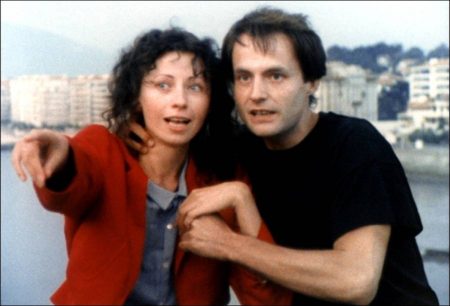The Green Ray movie storyline. Delphine’s (Marie Rivière) traveling companion cancels two weeks before her holiday, so Delphine, a Parisian secretary, is at loose ends. She doesn’t want to travel by herself, but has no boyfriend and seems unable to meet new people.
A friend takes her to Cherbourg; after a few days there, the weepy and self-pitying Delphine goes back to Paris. She tries the Alps, but returns the same day. Next, it’s the beach: once there, she chats with an outgoing Swede, a party girl, and a friendship seems to bud; then, suddenly, Delphine bolts, heading back to Paris. As she waits at the Biarritz train station, a young man catches her eye; perhaps a sunset and the sun’s green ray await.
The Green Ray (French: Le Rayon Vert) is a 1986 film by Éric Rohmer. It was released as The Green Ray in the UK and as Summer in North America, but is not part of Rohmer’s Four Seasons series. Rather, it is the fifth film of his Comedies and Proverbs. The film was inspired by the novel of the same name by Jules Verne. It was shot in France on 16mm film and much of the dialogue is improvised. The film won the Golden Lion and the FIPRESCI Prize at the 1986 Venice Film Festival.

In 1980 Rohmer embarked on a series of films each based on a proverb: the “Comedies and Proverbs”. The fifth of the series was The Green Ray in 1986. The theme was a phrase from Rimbaud: “Ah! que le temps vienne où les cœurs s’éprennent” (“Oh! May the time come when hearts fall in love”). Rohmer explained that “I was struck by the naturalness of television interviews. You can say that here, nature is perfect. If you look for it, you find it because people forget the cameras.”
As was becoming his custom in pre-production, Rohmer gathered his cast together to discuss the project and their characters, but then allowed each actor to invent their own dialogue. Rohmer stated that lead actress Marie Rivière “is the one who called the shots, not only by what she said, but by the way she’d speak, the way she’d question people, and also by the questions her character evoked from the others.”
The film was shot chronologically and in 16mm so as to be “as inconspicuous as possible, to have Delphine blend into the crowd as a way, ultimately, of accentuating her isolation.” Rohmer also instructed his cinematographer Sophie Maintigneux to keep technical aspects of the shoot to a minimum so as to not interrupt or distract the actors.
The film’s only major expense was a trip to the Canary Islands in order to film the green rays there. Rohmer chose to premiere the film on Canal Plus TV, a pay-TV station that paid $130,000 for the film, which was only one fifth of its budget. Rohmer stated that “Cinema here will survive only because of television. Without such an alliance we won’t be able to afford French films.” The experiment paid off when the film was a theatrical hit after being released three days after its initial broadcast.
The Green Ray (1986)
Directed by: Éric Rohmer
Starring: Marie Rivière, Béatrice Romand, Sylvie Richez, Vincent Gauthier, Amira Chemakhi, Maria Luisa Garcia, Laetitia Riviere, Virginie Gervaise, René Hernandez, Dominique Rivière
Screenplay by: Éric Rohmer, Marie Rivière
Production Design by: Françoise Etchegaray
Cinematography by: Sophie Maintigneux
Film Editing by: María Luisa García
Music by: Jean-Louis Valéro
MPAA Rating: None.
Distributed by: Les Films du Losange (France), Orion Classics (USA)
Release Date: August 29, 1986 (United States), September 3, 1986 (France), August 31, 1986 (Italy)
Views: 343

